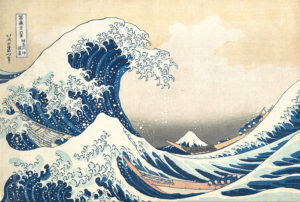Daydreams & Debussy

When I decided to become a piano teacher in the 70s, I began studying with expert teachers. Louise Kupelian assigned Debussy’s Arabesque to help me master the challenge of playing triplets in one hand and duplets in the other. Click here to hear me play this piece while you continue to read. In 1984 I had the chance to buy a beautiful painting from Washington artist Leon Berkowitz. He told me that the twenty washes of paint he applied were inspired by the quality of light he had seen in two places: Israel and West Texas. That sold me right there! Then he asked what composer this work brought to mind. “Debussy,” I said, “of course,” thinking of Arabesque. He then wrote “Homage à Debussy” on one edge of the canvas-wrapped frame. For thirty years this painting hung near the piano in my living room in Arlington. With a rheostat, I could change the light and suggest to my students ways to color and shape phrases. The work now hangs in our dining room and is a favorite background for photos. It’s a constant reminder to play the piano colorfully.

In early July Steve and I will be meeting Lilli and Violet, shown on the right, in Paris for six days of seeing sites and visiting our dear friends, the Le Pechons. To prepare, I’ve been studying French every day and practicing pieces by Debussy. A piece new to me was “Reverie,” variously defined as daydreaming, fantasy, mindfulness or meditation. What does this music bring to your mind?

When I played “Reverie” for my present teacher, Lisa Leonard, I told her I was puzzled by some sudden dynamic changes Debussy indicated. She pointed out that big waves are usually followed by small ones. That made me recall a lecture on Debussy’s “La Mer” that I once heard by Rossen Milanov, the orchestra conductor at Chautauqua. He told how Debussy was enamored by the Gamelan he had heard at the Paris Exposition of 1889, celebrating the centennial of the French Revolution. According to Wendy Thompson’s biography of Claude Debussy,
Debussy could not tear himself away from the Javanese Pavilion at the Fair. Here, for the first time, he heard an entirely new kind of music…tuned gongs, bells, xylophones, and tiny cymbals creating endless combinations of ethereal, flashing timbres…hypnotic Oriental music based on five-note, or pentatonic, scales.” Rossen Milanov, traced Debussy’s experience with the gamelon directly to his composition of the symphonic work,”La Mer,” in 1903. He pointed out that the cover of the first edition of La Mer featured a reproduction of Japanese artist Hokusai’s famous Wave, underlining the Asian influence on his work.
Milanov observed that audiences are often shocked by La Mer. It’s in constant motion with very little structure to hold on to. Two harps, English horn, shimmering strings, muted trumpets and gongs make it an experience for the senses…..It starts very quietly, then builds to big waves of sound with dramatic crescendos. Milanov termed it life-affirming, but said it also displays human insignificance in comparison with the sea. One can listen to La Mer on a device, but hearing it live in a large amphitheater at Chautauqua under Milanov’s expert direction, was a tremendous sensual experience.
“Reverie” and “Arabesque” are not as complicated as “La Mer,” but they represent Debussy’s artistry in a way that I can share. I offer my performances as a way to communicate with my listeners. This week I played both “Arabesque” and “Reverie” for several friends, showing them a napkin depicting that Great Wave. Jack told me that my remarks gave him specifics to listen for. Peter was reminded of the love his late wife had for “Arabesque.” Angela recalled that Tony Bennett had sung a piece called “My Reverie.”
Sure enough, I found Bennett’s recording from 1955, but the version I liked best was by Larry Clinton and his Orchestra in 1938, featuring a singer whom Nick recalled, Bea Wain. Yes, Larry Clinton put words to Debussy’s melody! Jeanne liked the poetry and took home a print-out.
Our love is a dream, but in my reverie
I can see that this love was meant for me
Only a poor fool never schooled in the whirlpool
Of romance could be so cruel as you are to me
My dreams are as worthless as tin to me
Without you life will never begin to be
So love me as I love you in my reverie
Make my dream a reality
Let’s dispense with formality
Come to me in my reverie.
After our visit with friends in Paris, we will go on to Berlin later in July to see the family of my godson. I have been reviewing my German every day and playing pieces by German composers, too. One of my old favorites, “Träumerei” by Robert Schumann, (Kinderszenen–Scenes from Childhood, Opus 15) also translates as “daydreaming.” Composed 50 years before Debussy’s Reverie, it happens to be in the same key, F major, and have the same 4/4 time signature. But the two daydreams are so different! Schumann wrote this group of piano pieces for Clara, the daughter of his teacher, Friedrich Wieck, long before they married and had many children together. He intended it to represent scenes from his own childhood, so that she could know him better despite her father’s opposition to him as a suitor. I, for one, think that daydreaming was integral to Robert Schumann’s creativity.
What does daydreaming mean to you? Is it helpful meditation or futile thinking? Which of these reveries do you prefer? Have any of your daydreams inspired you to create, to improve relationships, or bring you peace?
 Taking Reverie a step further: Focusing on reveries has prompted me to read The Book of Joy: Lasting Happiness in a Changing World by the Dalia Lama, Desmond Tutu, and Douglas Abrams. Two Nobel Peace Prize winners spent five days with Abrams, an author, editor, and literary agent, in Dharamsala, India in April 2015. The Eight Pillars of Joy they discuss give me new challenges for meditation and mindfulness.
Taking Reverie a step further: Focusing on reveries has prompted me to read The Book of Joy: Lasting Happiness in a Changing World by the Dalia Lama, Desmond Tutu, and Douglas Abrams. Two Nobel Peace Prize winners spent five days with Abrams, an author, editor, and literary agent, in Dharamsala, India in April 2015. The Eight Pillars of Joy they discuss give me new challenges for meditation and mindfulness.
In August I’ll be studying this book in detail with my Monday Morning Group. One thing I’ve already learned is that Lama is a title for a teacher of the Dharma in Tibetan Buddhism. Llama, by contrast, is a domesticated South American camelid, widely used as a meat and pack animal by Andean cultures since the Pre-Columbian era (see photo in Machu Picchu.) And here’s a link to how you can watch this film (for a fee that supports a charity) about the Dalai Lama and Archbishop Tutu.
Leave a Reply